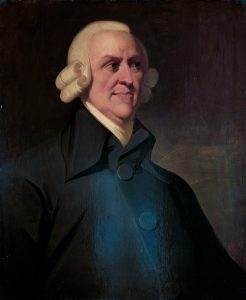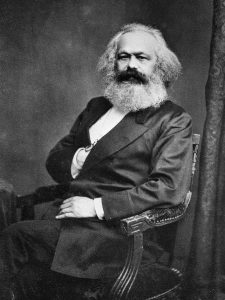1. Racial Capitalism and Colonialism
Back Up, What is Capitalism?
 Reflection 2
Reflection 2
Before you begin, enter your reflection journal and respond to the following questions:
- Where do you notice capitalism operating in your daily life?
- What may not look or seem like capitalism, but actually is?
Note: to access your reflection journal please review the Introduction section of the Racial Capitalism and Colonialism module.
Okay, let’s dig a bit deeper into what capitalism is about. In Video 1: Racial Capitalism and Colonialism, our narrator began to describe Capitalism. Listen to the audio clip or read the transcript below for a refresher.
 Audio Clip from Video 1
Audio Clip from Video 1
Transcript
“Most of us think we know, or at least have a loose idea of what capitalism means. You may even be familiar with some form of this definition: An economic system where private entities own the factors of production. The four factors of production are entrepreneurship, capital goods, natural resources and labor. The system is supported by laws, policies and regulations. It lays out a set of norms that we all follow, as well as pieces we don’t really feel like we have much say in. We all support capitalism in numerous ways, even if we don’t want to, even if we don’t notice. It might even seem to be both normal and like the only – and best – system we have. Since the effects of capitalism are broad and far-reaching, even if you live completely off the grid in a community and culture that is anti-capitalist, you are touched by capitalism.” (Video 1, 0:44 to 1:42)
Let’s break this down a bit further. Click on each image to learn more.
To explore the Four Factors of Production further, check out the video below.
In capitalism, individuals are seen as private entities who supposedly own their own labour and sell it for a wage. Classic scholars of capitalism say it starts with the industrial revolution and with what is often understood as the advent of modern society. You may have heard about Adam Smith (1723-1790) and Karl Marx (1818-1883), two key economic and political theorists whose extensive work on capitalism continues to form the basis of our understanding today. Let’s take a deeper look at their theories.
Adam Smith

The first most popular theorist of capitalism is Adam Smith, who in 1776 wrote “The Wealth of Nations” which argues for “laissez-faire” economic policies in which the market is free to self-regulate. With minimal government intervention and taxation of free markets, Smith said, an “invisible hand” would regulate the market itself. Supply and demand would be managed naturally according to consumer needs: if suppliers met the needs and wants of consumers in a satisfactory way, they would be paid well for it.
Smith argued that this invisible hand was a natural phenomenon that would work out well for everyone because humans are naturally competitive and the need to turn a profit would make us do our best to create good products other people would want to buy. For Smith, the market would help to create a “wealthy” nation- full of productive hard-working citizens reaping the rewards of their hard work.
 Reflection 3
Reflection 3
The video below provides an overview of Adam Smith’s work. Remember to engage with this content with critical thinking, discernment and intellectual generosity.
Watch the video below and consider the following in your reflection journal:
- What may be missing from this particular video? For example, what about the context and times in which Smith lived? What was happening globally to sustain the growth of consumerism?
Note: to access your reflection journal please review the Introduction section of the Racial Capitalism and Colonialism module.
Karl Marx

The other most famous theorist of capitalism is Karl Marx, who comes along 100 years later. Marx’s critiques of and predictions about capitalism remain some of the most important of our time, and people continue to study and dissect them with gusto. Marx made eerily accurate predictions about the trajectory of capitalism. First, some basics on Marx’s theories.
Marx observes the driving force of capitalism is the endless accumulation of profits, which come from surplus value that can be squeezed out of the goods and services you and I purchase. Since there are often fixed prices for things like an egg or a plank of wood, Marx observed that the easiest way to acquire surplus value was through labour, or rather, acquiring labour for the cheapest possible price.
As an employer, you get labour out of people in a couple of ways: you can make your workplace really appealing to work at, or you could make sure the people you employ are really desperate for work.
Remember that Marx lived during the industrial revolution, one of the most miserable moments of all time to be a worker: many of the regulations and norms we have today did not yet exist. Being a factory worker meant long hours, six days a week of work, child labour, no days off, exposure to dangerous conditions and no protections. The people who needed to work these kinds of jobs had no other options. The people they worked for were generally rich and getting richer off of the accumulated surplus of the wage workers.
Marx argued that under capitalism, this idea that individuals could own their labour- thus selling it at their own decided price and nurturing a society in which goods and services are exchanged through a healthy system where everyone benefits- is false. Under capitalism, workers don’t own the means of production, so when they sell their labour, they don’t set the prices: their employers do. Essentially this means that workers are treated as machines working to produce profits for owners, who make profits by not giving workers their fair share of the profits. The employers in fact have an incentive to maximize profits while minimizing worker’s rights to share in the profits.
Marx thus observes that society is characterized by a class struggle: between the proletariat (workers) and the bourgeoisie–the employer class who own the means of production. This observation has been a driving force in social movements fighting for the rights of workers, including unions formed to establish labour protection laws, and political movements toward communism that advocate for major government intervention in the production and distribution of goods.
In recent decades, theorists have argued that capitalism didn’t just start with factories circa the 19th century, but actually began much earlier, with the enclosure of the commons and the beginning of an agrarian economy in which rural landholders were pushed from their lands and forced into wage labour, which happened throughout Europe in the 17th and 18th centuries. Those who were seizing land from rural populations required laws of private property. We will continue to explore this in the next section on the Modern Nation-State System (section 1.4)
 Reflection 4
Reflection 4
Watch the video below and consider the following in your reflection journal:
- After watching the video about Karl Marx, consider why the concept of race does not feature in Marx’s analysis.
Note: to access your reflection journal please review the Introduction section of the Racial Capitalism and Colonialism module.
Cedric Robinson
 Let’s go back to Video 1: Racial Capitalism and Colonialism, where our narrator discusses how Cedric Robinson builds on these ideas to identify what he calls racial capitalism. Listen to the audio clip or read the transcript from video 1 below.
Let’s go back to Video 1: Racial Capitalism and Colonialism, where our narrator discusses how Cedric Robinson builds on these ideas to identify what he calls racial capitalism. Listen to the audio clip or read the transcript from video 1 below.
 Audio from Video 1
Audio from Video 1
Transcript
“Cedric Robinson points out that capitalist production thrives on creating surplus value by devaluing labour, or making labour as cheap as possible. He argues that therefore, the perfect way to devalue labour is to create levels of unequal humans. In the Atlantic slave trade, people were dehumanized, stolen from their lands and forced to work for free. This was the ultimate way to create surplus value and power for the ruling classes. Robinson calls this “racial capitalism.” Racism and capitalism are not separate. Capitalism requires the construction of the idea of race. The slave and the indentured labourer are fundamental to capitalist production. Economic and political theorists during the rise of capitalism, like Adam Smith and John Locke, spoke of ‘natural human rights and laws’. These were based on the idea that the natural human was the Western European man. The Western European man had the right to private property and other forms of ownership while the rest of humanity was excluded from these rights.” (Video 1, 4:27 to 5:38)
 Check Your Understanding
Check Your Understanding
Recommended Further Reading
- Kimberly Amadeo, “What is Capitalism?”, the balance, October 21st, 2021 (article)
- Todd Gordon and Geoffrey McCormack, “Canada and the crisis of capitalism,” Briarpatch magazine, February 25th, 2020, (article)
- Annie Lowrey, “Why the Phrase ‘Late Capitalism’ Is Suddenly Everywhere,” The Atlantic, May 1st, 2017 (article + video)
 Music
Music
For a transcript of the lyrics for the above song visit Genius’s page for Thirteen.
For a transcript of the lyrics for the above song visit Genius’s page for The Taker.
 Reflection 5
Reflection 5
Open your reflection journal and respond to the following questions:
- How may your response from the beginning of this chapter (reflection 2) be different (or not) when considering Cedric Robinson’s contributions?
- Reflect on the ways that capitalism and colonialism are inextricably linked.
Note: to access your reflection journal please review the Introduction section of the Racial Capitalism and Colonialism module.

